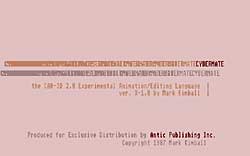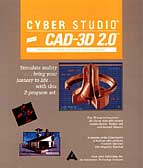Cybermate (Cyber Studio)
Cybermate was a Forth-based authoring language created by Mark Kimball that was supposed to be used to edit, sequence and present the animation files along with sound. By writing Forth scripts, you could control when and how fast a video or audio segment played, and you could do looping. Cybermate was basically a precursor to systems like Macromedia Director; it was published together with CAD-3D 2.0 as the product Cyber Studio.
Mark Kimball’s delta animation format for CAD-3D is notable as one of the first actual implementations of a compressed digital video format, an antecedent of systems like QuickTime. When it was originally developed, the only way to play back this format was with a simple stand-alone player program. In fact, all you could do was play back exactly what CAD-3D and Cyber Smash had saved to disk, without modification or sound. Foreseeing these limitations as weaknesses in the product, Gary asked Mark to produce a more flexible playback system. Mark explains:
Cybermate began as a simple animation scripting scheme, but I quickly became dissatisfied with the very limited options that approach imposed. I came across an article in Byte by Dick Pountain about an object-oriented version of Forth, which seemed to answer a lot of the problems I had with the limited-option approach. So I began adapting a Forth program to include the object-oriented method. I quickly discovered that the Byte article had been based on a very different dialect of Forth, so a lot of modifications were needed. But after that, the power of the object-oriented Forth quickly became apparent. Subsequent additions to the basic Cybermate core proved to be very simple and intuitive (to me at least), so its power was never limited by the original design of the animation “scripting” paradigm.
In addition, Forth was very nice because it was fast in execution and provided quick feedback regarding problems, so the code/debug cycle was pretty quick. Its built-in compiler and text editor further shortened the development cycle. Keep in mind that there were not very many good development environments around at that time, and none that allowed potential users to employ the same environment to write their own animation sequences!
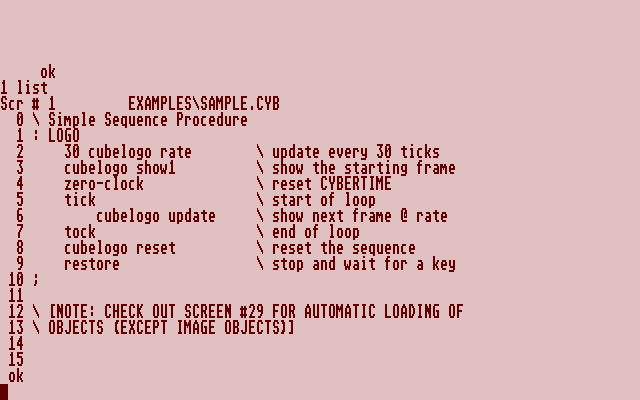
Cybermate’s development environment with a page of sample code
On paper, Cybermate is pretty impressive for the day, especially in its ability to work with stereo animations. However, it turned out that Cybermate had problems. The first—ironically—was Forth. Forth is a unique and legendary computer language, but despite being much easier to use than its reputation suggests, it contains peculiarities that have dogged the language throughout its considerable history. The Forth problem was compounded by Antic’s choice to provide the 73-page Cybermate manual on disk only, not in printed form. This in an era when a great many computer users didn't own printers (due to their relatively high cost) and when there was no good way of reading the documentation on the computer’s display. (There was no Web, no Acrobat, no widespread word processors, and screen resolutions were far too low to fit a full page, legibly.) If this wasn't enough to doom the product, Cybermate was quite crash-prone, which swiftly dissuaded all but the most determined user from working with it. Mark concludes:
The most successful aspect of Cybermate was that it could be used in an interactive environment, where code could be immediately tested. Its least successful aspect was that it was a very deep environment. Linux hackers would like it, but perhaps few others nowadays.
I worked on a 32-bit version of Cybermate, to get around its memory limitations, but Cybermate died as a commercial product long before it ever came out. It was necessary to develop a 32-bit version of Forth, which was quite a departure from the Forths of the time, so a lot of work went down the drain there.
Cybermate never really got a chance to mature. Although they were fundamentally different products, in most users’ minds Cybermate was supplanted by Cyber Paint. Mark went on to contribute to Cyber VCR and explore other computer graphics interests:
I published a morphing program which worked with the Cyber Studio version of CAD-3D and was fairly successful. It made it up to version 4 of “Meta”, so I called it “Meta4”. It was published in ST magazine. I worked on a fast ray tracing program, which used CAD-3D-style objects, as a sort of test bed to test other ideas-and it worked pretty good. Never made it to a commercial product, however, and never was published.
Personally, I married, became interested in growing Rhododendrons (which grow very well in the Pacific Northwest), wine making, hunting mushrooms, making soap, hiking and gardening. Doesn't leave much time for hacking nowadays, but who knows what the future will bring. I have been doing some work with Linux, and I like the platform, so who knows... .
Two complete Cybermate projects (including G.I.S.T. sound) can be seen here as (large) QuickTime movies:
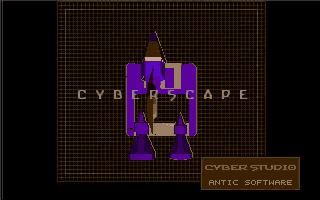
Darrel Anderson’s Cyberscape
Quicktime MOV (40MB)
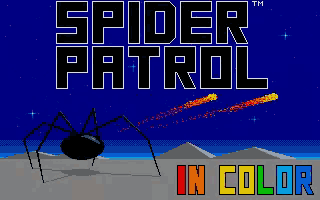
Tom Hudson’s Spider Patrol
Quicktime MOV (56MB)
Morphing
The computer-assisted distortion of one shape into another over time. As a two-dimensional process, morphing emerged as a cinematic technique in the late ’80s and early ’90s in films such as Terminator 2, and is now a ubiquitous tool in special effects work. Morphing can also refer to 3D geometry distorting into a different 3D shape.
Ray tracing
One of two dominant approaches to rendering a picture of a 3D scene; the other being scan-line rendering. Raytracing is the meticulous simulation of “rays” of light as they trace (usually backwards) from the viewpoint (eye) into the scene, where they may bounce from surface to surface. Raytracing is especially adept at simulating shiny reflections.
Run time edition
A packaging of data (in this case animation and sound information) with just enough executable code so that the data can be re-used (in this case, played back for the user) without the original application software from which it originated.
Authoring
In the computer world, authoring refers to general creative assembly and sequencing of multimedia elements. Originally associated with the creation of CD-ROM multimedia software, authoring now applies to many media including the Web and DVDs. Authoring usually implies a lightweight process, as opposed to programming.
Development environment
Programming tends to center around the activity of editing text files. Development environments are applications that provide various features that make this activity more efficient.
FORTH
A unique, idiosyncratic, but highly efficient computer language created in 1970 by Charles Moore.
